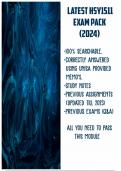,This document contains:
Study Notes
Previous Exams/Assignments (Questions & Answers)
TABLE OF CONTENT
Study Notes Page 3
Assignments 2020 Page 58
Assignments 2021 Page 74
May/June 2021 Page 88
September/October 2021 Page 91
Assignments 2022 Page 93
January/February 2022 Page 105
Assignments 2023 Page 107
, STUDY NOTES
Different Types of Sources
Primary sources
These are first-hand clues or sources from the actual time period. It is important to remember that evidence from
the past is never complete. Much primary evidence has yet to be forgotten, lost or destroyed.
Secondary sources
This is processed information that takes the form of people speaking or writing about evidence long after the
event. Information presented in secondary sources is based on evidence from primary sources. They are called
secondary sources because whoever has written them has put in their conclusions and ideas, and too, it is not just
evidence. A school textbook is an example secondary source.
Primary sources Secondary sources
A primary source comes from the time the historian is A secondary source is a product or account made by
studying. people that have studied and interpreted the primary
Examples are letters, paintings, old coins, stone age sources.
implements, autobiographies, speeches, pictures, Examples of secondary sources include textbooks,
interviews, newspaper articles etc. biographies, scholarly books, newspaper articles etc.
Interpreting Different Types of Source
Written sources
These include books, articles, speeches, biographies and autobiographies.
You will be required to extract, interpret, analyse or synthesise information from these sources.
Pay attention to the context.
A source should be read in its context; this includes the date, the producer, the reason it was produced, and
the events surrounding it.
When was it produced?
If it is during the event (speech) or long after the event (a historian writing about the impact of the speech)
Who produced the source?
This could be an ordinary citizen, politician, academic, journalist, or artist.
Why was this source produced?
Sources can either be produced for information sharing, propaganda or artistic expression
What key events is it referring to?
The source will be adding to or providing a new perspective of what you already know of the event, i.e.
The Cold War
What are the key concepts?
Here you can compile a glossary of important historical concepts for the topic.
Visual Sources
Photographs
A photograph makes for a very valuable historical source; it is usually taken at the time of the event. To analyse
the picture, you still need to apply context as outlined above, which has implications for its reliability.
Who took the photo?
This could be a journalist, photographer or ordinary citizen- it may be important here to find out whom the
photographer is taking the picture for.
Why was this photo taken?
The picture is taken to be published in a newspaper article, either for propaganda or information sharing.
, Which perspective is depicted in the photo?
This can be from an ordinary citizen’s perspective or an elevated position, i.e. a politician giving a speech
showing the audience or parts of the audience that seem to be supporting them. The subject the photographer has
chosen to focus on in the photo indicates their viewpoint.
What is missing in the photo?
Determine if there are subjects or objects from this historical event that needs to be shown in the picture and
whether this prevents you from getting a clear view of the event.
Has the picture been manipulated?
Has the photographer cropped or removed some elements of the picture to emphasise others?
Cartoons
A cartoon is a drawing that depicts/ shows a historical event.
To analyse the cartoon, you will need to ask the following:
Who drew the cartoon?
This is usually a cartoonist.
Why was this cartoon was drawn (intention)
This can be to mock (satire), ridicule, support, criticize, condemn or artistic expression.
What is the message of the cartoon?
To determine the message, you need to pay attention to the following:
Exxageration
Caricature
Symbolism
Transportation
Evidence
Speech bubbles
How To Determine The Value of a Source
To find out if a source is reliable/can be trusted, you need to ask the following questions:
Who wrote it?
When was the source made?
Why was it created?
Is the source biased in any way?
Does this source offer a limited view of the event?
Is the evidence in the source consistent with evidence from another source?
Quick tip
When reading the context and content in the source, you may look for these tell-tale signs of the reliability of a
source.
Key question Reliable Unreliable
Who wrote it? A person who experienced the A person who has not
event (first-hand). experienced the event and is not a
A journalist, historian or analyst scholar on the subject.
wrote them. A political leader/affiliate.
When was the source made? During the time of the event. Long after the event has taken
place.
Why was it created? Information sharing Propaganda
Is the source biased in any way? Presents both perspectives or Presents one point of view
sides of the events.
Does this source offer a limited view Provides as much detail about the There is important information
of the event? event. about the event that is missing.
Is the evidence in the source Other sources you have read No other sources exist to prove it
consistent with evidence from another prove that event/perspective to be true.
source? true.




